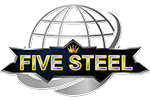As we all know, once the body surface of galvanized steel pipe has been attacked and the zinc hydroxide compounds have formed, it is desirable to remove the oxide products from the surface. Generally speaking, there are two major reasons: 1.their presence inhibits the formation of stable carbonate based oxides; 2. the effect on the galvanised coating can range from very minor to extremely severe and various levels of remedial treatment are available to deal with white rust problems at the various levels at which they are likely to occur.
There are a few treatments are recommended to deal with white rust on galvanised products as follows:
1. Light White Rusting
This is characterized by the formation of a light film of white powdery residue and frequently occurs on structural steel pipes during periods of heavy rain. It is particularly evident on areas that have been buffed or filed during quality assurance operations. These treatments remove the passivated surface from the galvanizing and expose unoxidised zinc to attack from rainwater. Provided the items are well ventilated and well drained, white rust rarely progresses past this superficial stage. It can be brushed off if required but will generally wash off in service with normal weather. No remedial treatment is generally required for this level.
2. Moderate White Rusting
This is characterized by a noticeable darkening and apparent etching of the galvanised coating under the affected area, with the white rust formation appearing bulky. The galvanised coating thickness should be checked by professional steel pipe manufacturers to determine the extent of attack on the coating. In the majority of cases, less than 5% of the galvanised coating will have been removed and thus no remedial work should be required as long as the appearance of the affected area is not detrimental to the use of the product and the zinc hydroxide residues are removed by wire brushing.
3. Severe White Rusting
This is characterized by very heavy oxide deposits. For example, that often occurs where there are many cold rolled steel pipes stuck together. Areas under the oxidized area may be almost black and show signs of red rust. A coating thickness check will determine the extent to which the galvanised coating has been damaged. In such cases, it is suggested that we wire brush or buff the affected area to remove all oxidation products and rust if any. Or we apply one or two coats of approved epoxy zinc-rich paint to achieve required dry film thickness of 100 microns minimum.
Send your message to us:
Post time: Jul-29-2019





